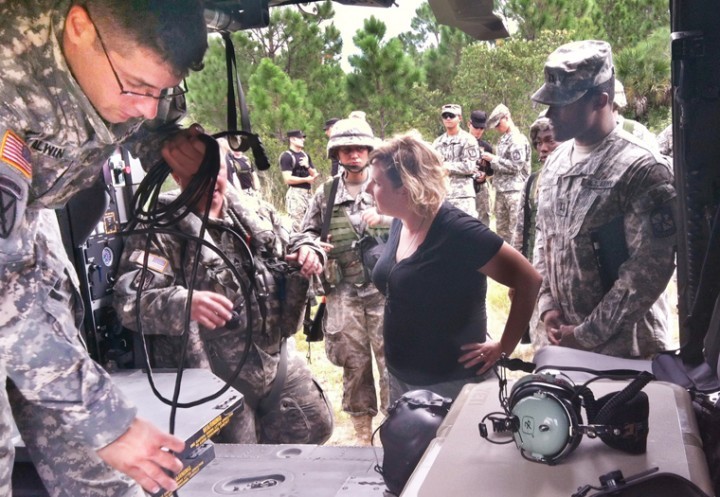FELLSMERE — It could have been a scene from the classic television show M.A.S.H, or an image from the battlefields of Afghanistan, but in reality it was a clearing in the woods in Fellsmere.
In an unannounced mission closed to the public, a U.S. Army Blackhawk helicopter and its crew out of Cecil Field in Jacksonville spent a day training cadets from the Florida Institute of Technology ROTC program on City of Fellsmere property.
Sister publication The Sebastian River News was the only media granted access.
The training ground, a public-private collaboration between the City of Fellsmere and the college, is just 200 meters west of Interstate 95. Commuters that day may have thought they were experiencing mirages from the extreme heat as they spied the Blackhawk taking off and landing a dozen times on civilian turf.
The UH-60 “Mike” Blackhawk is the newest model, weighing in at 22,000 pounds fully equipped and capable of transporting six injured soldiers and carrying a crew of up to four people.
The Blackhawk can fly at speeds of up to 140 knots and sustain altitudes of up to 10,000 feet for two hours.
Not many people get to see one up close or feel the tropical storm force winds created when it takes off, let alone climb inside for a ride like the cadets did.
The event was special enough to tear Fellsmere Mayor Susan Adams away from her customers at Marsh Landing Restaurant for about an hour.
“I just think it’s really amazing that we have this great partnership with such a professional organization. Florida Institute of Technology is top notch and everything they bring to the table is top notch,” she said. “It’s awesome what they’re bringing to the city and to their program.”
Sergeant First Class Glenn Baker, senior military instructor with the ROTC, accompanies the ROTC cadets three to four times per year to training at the Fellsmere facility.
Normally, the students use the zip line in the woods, scale the rock-climbing wall, stage war games on the property or use it for physical conditioning – nothing as exciting as simulating emergency medical evacuations or MEDEVAC training.
Baker missed the Fellsmere mission because he was dispatched out of state, but said, “The ROTC has waited years for this training.”
The Army doesn’t just let the $5 million craft and its highly trained crew venture about on whim. In fact, it took six months of navigating Army red tape to get the Blackhawk and its crew out of Jacksonville and down to Fellsmere.
The reason it finally came together was because two determined people – one Ranger cadet and one Blackhawk pilot who crossed paths at Florida Tech – wouldn’t let up until the powers that be finally said “yes.”
First Lieutenant Shawn Webster, of Virginia, a 2008 graduate of Florida Tech, pilots the Blackhawk with the Florida Army National Guard, Charlie Company 111th Aviation Regiment.
He worked with Ranger Cadet Major Lacey Sovern, of Cape Coral, Fla., a senior at Florida Tech, to get the clearance for the crew to train the 15 cadets competing for a spot in the elite Ranger Company at the college.
Wallace was one of Sovern’s mentors and instructors when he was a senior and she was a freshman and they wanted to bring this advanced training to the program.
“It was absolutely worth what we had to do to get this. These cadets would never get this type of experience unless they go to air assault training,” Sovern said. “It’s important to see this in a real life situation.”
Sgt. Jason Hughes, of Gainesville, who has served as a flight medic on Blackhawk crews for 16 years, explained to the cadets that, in a battlefield scenario, they would need to secure the landing zone and to stop the injured soldier’s bleeding before the helicopter arrives.
The next two important things are communicating with the helicopter crew and approaching and exiting the landing zone safely, since the blades of the chopper come down as low as four feet at certain points upon landing.
The last thing the medical evacuation crew wants, he said, is to create more casualties on the ground from the helicopter blades.
Cadets practiced loading a student onto the stretcher, called a “litter pan” and loading them into the Blackhawk.
Then two cadets climbed into the helicopter as it circled around Fellsmere and came back for another round.
Cadets practiced unloading the “patient” and loading another one in safely.
They did this until all 15 cadets got to ride in the helicopter, either as injured or as crew.
Then the Blackhawk crew demonstrated, with a dummy, how they pick up an injured soldier when the area either has too much vegetation to land or is otherwise too dangerous to land.
The aircraft hovered at about 150 feet off the ground, creating violent winds that tossed around tree branches, mulch and dirt and forced bystanders to seek cover in or near the repel tower.
Of the 15 cadets vying for a spot on the Ranger Company, only one or two of them will complete all the phases of the program and be granted the “black hat” of the Rangers.
Along with that often comes an instructor position with the ROTC program and a full scholarship for their courses at Florida Tech.
For many cadets, that’s the only way they can afford the private technical college.
Capt. Lawrence Lewis, a West Point graduate who heads up the Florida Tech ROTC program, said the training his cadets got in Fellsmere with the Blackhawk could very well save lives as his cadets are deployed in harm’s way after they graduate and go off to lead other soldiers.
“I’m not training people to take orders and follow directions,” Lewis said. “We’re training people to make decisions and to take initiative.”

